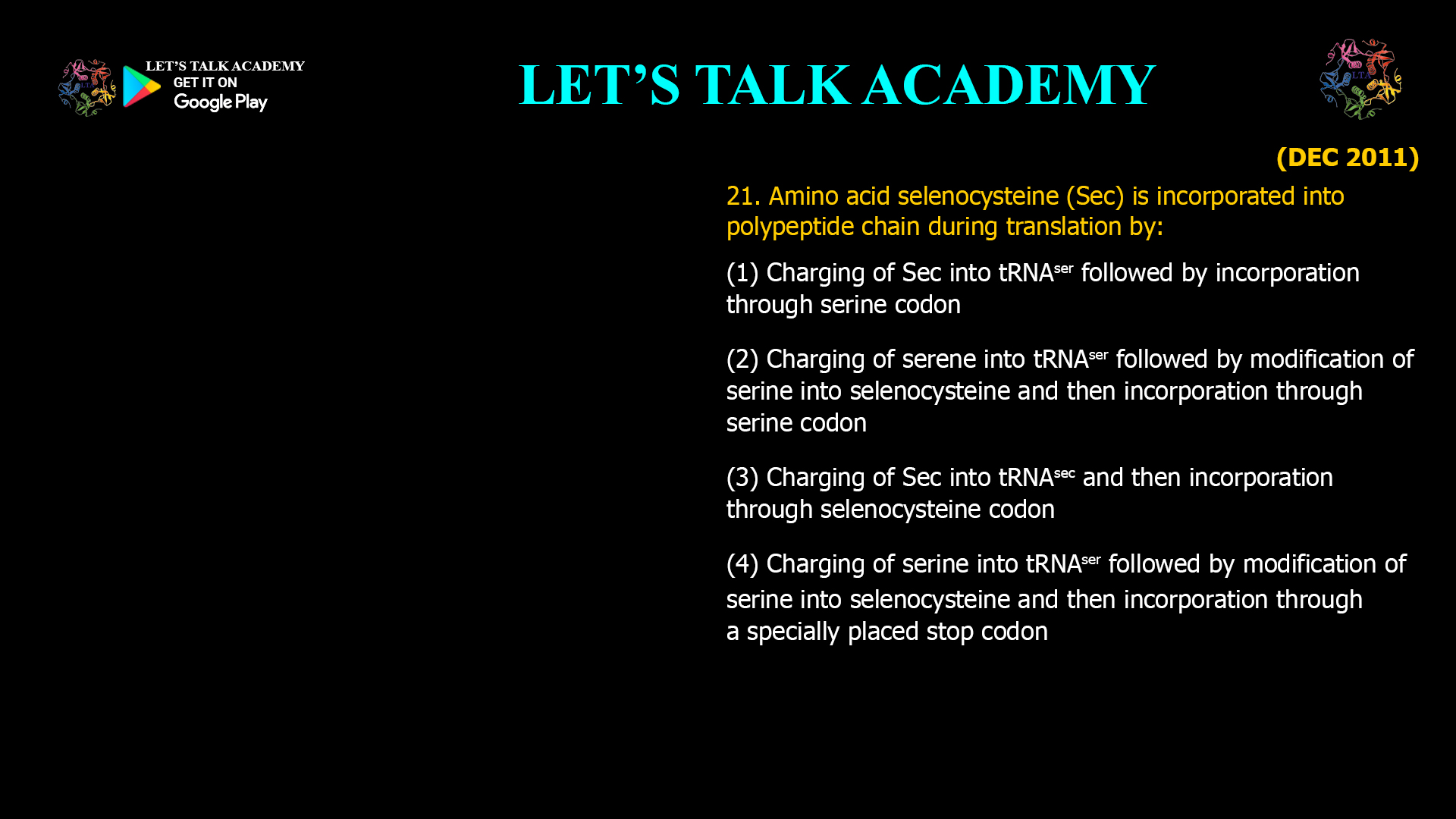- Amino acid selenocysteine (Sec) is incorporated into polypeptide chain during translation by:
(1) charging of Sec into tRNAserfollowed byincorporation through serine codon
(2) charging of serene into tRNAserfollowed by modification of serine into selenocysteine and then incorporation through serine codon
(3) charging of Sec into tRNAsecand then incorporation through selenocysteine codon
(4) charging of serine into tRNAser followed by modification of serine intoselenocysteine and then incorporation through a specially placed stop codonHow Selenocysteine (Sec) Is Incorporated into Proteins During Translation
Selenocysteine (Sec) is known as the 21st amino acid and is uniquely incorporated into proteins during translation. Unlike the standard 20 amino acids, Sec incorporation requires a specialized mechanism because it is encoded by what is normally a stop codon (UGA).
Mechanism of Selenocysteine Incorporation
-
Charging and Modification:
Selenocysteine is not directly charged onto a unique tRNA initially. Instead, serine is first charged onto a specialized tRNA called tRNA^Sec. This tRNA is distinct from the regular tRNA^Ser. -
Conversion of Serine to Selenocysteine:
After charging, the serine attached to tRNA^Sec is enzymatically converted into selenocysteine while still bound to the tRNA. -
Incorporation at UGA Codon:
The UGA codon, which normally signals translation termination, is recoded to incorporate Sec instead. This recoding requires a selenocysteine insertion sequence (SECIS) element in the mRNA and specialized protein factors such as Sec insertion sequence binding protein 2 (SBP2) and a Sec-specific elongation factor (eEFSec). -
Delivery to Ribosome:
The Sec-tRNA^Sec complex is delivered to the ribosomal A site at the UGA codon, allowing Sec to be incorporated into the growing polypeptide chain.
Explanation of the Options
Option Description Correctness (1) Charging Sec into tRNA^Ser followed by incorporation through serine codon Incorrect (2) Charging serine into tRNA^Ser followed by modification to Sec and incorporation through serine codon Incorrect (3) Charging Sec into tRNA^Sec and incorporation through selenocysteine codon Incorrect (Sec is not directly charged) (4) Charging serine into tRNA^Sec followed by modification to Sec and incorporation through a special stop codon Correct
Summary
Selenocysteine incorporation is a unique co-translational process involving:
-
Charging of serine onto tRNA^Sec
-
Enzymatic conversion of serine to selenocysteine on the tRNA
-
Recognition of the UGA stop codon as a Sec codon facilitated by the SECIS element and specialized factors
-
Incorporation of Sec into the polypeptide chain at the UGA codon site
Keywords for SEO Optimization
-
Selenocysteine incorporation mechanism
-
Sec-tRNA^Sec charging and modification
-
SECIS element in selenoprotein mRNAs
-
UGA recoding for selenocysteine
-
Translation of selenoproteins
-
Sec-specific elongation factor eEFSec
-
Selenocysteine biosynthesis and incorporation
-
Co-translational amino acid incorporation
-
Molecular biology of selenoproteins
-
Protein synthesis with non-standard amino acids
Conclusion
The incorporation of selenocysteine into proteins occurs by charging serine onto a specialized tRNA^Sec, followed by enzymatic modification of the serine to selenocysteine. This Sec-tRNA^Sec is then incorporated at a UGA codon recoded as a Sec codon through the action of SECIS elements and specific elongation factors. Therefore, the correct answer is:
(4) charging of serine into tRNA^Sec followed by modification of serine into selenocysteine and then incorporation through a specially placed stop codon
-



